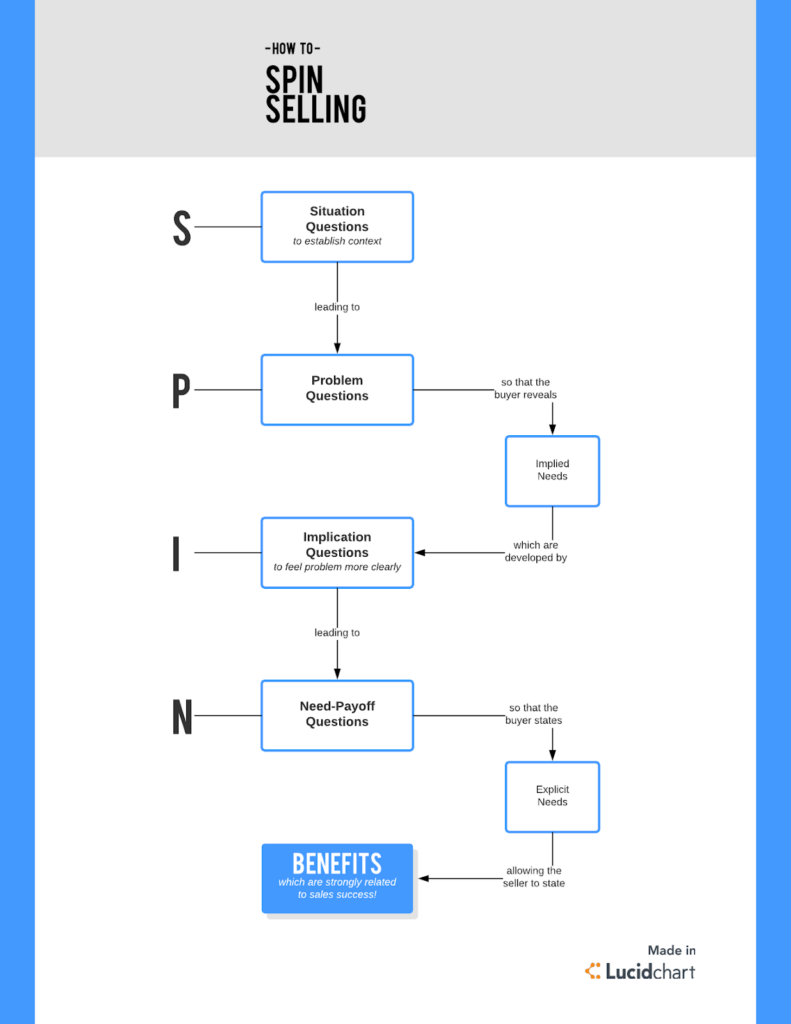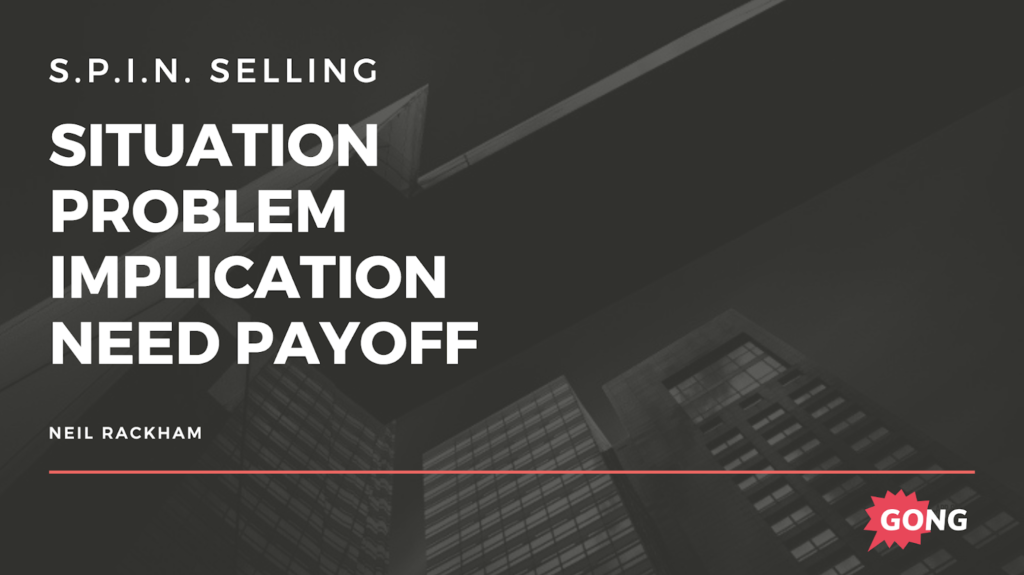SPIN Selling: A comprehensive guide
The SPIN Selling Methodology is similar to Solution Selling. It relies on great sales discovery and question-asking to help customers understand their problems, how impactful they are, and what the best solution might look like.
The sales world is not short on sales methodologies.
We blogged about what we believe are the top 12. Clearly, there are more than 12. And obviously, that is our take on the top 12.
Most organizations — especially those with more mature sales teams — implement a sales methodology to standardize sales within the company. Leveraging a specific sales program helps:
- Sales managers track what is working (and what is not)
- Pinpoint where sales reps need more coaching
This article will not review every single methodology on the market. There may be a brand new one being developed as you read this, for all we know.
We’ll be focused on just one: SPIN Selling.
What does S.P.I.N. stand for?
Situation.
Problem.
Implication.
Need Payoff.
The SPIN Selling Methodology is similar to Solution Selling. It relies on great sales discovery and question-asking to help customers understand their problems, how impactful they are, and what the best solution might look like.
Situation: Information-gathering, qualifying questions.
Problem: Raw material questions that get buyers talking about their issues and needs.
Implication: Questions used to pull out consequences of buyers’ problems.
Need Payoff: Questions used to uncover the benefits of solving a problem.

The origins of SPIN Selling
What sets the best salespeople apart from the rest?
The trillion-dollar question. One that in the 1970s was not super-easy to answer without a boatload of research.
In the 1970s, Neil Rackham and his team set out on a quest to answer that question — using data. Sound familiar? It took a decade+, but the answer was finally culled from over 35,000 sales calls.* At the time, this was the most extensive study of its kind. It quickly disproved several mainstream sales practices.
*Clearly, this was done in a pre-Gong world, before call recording software was a thing.
Rackham uncovered a few key points:
- Open-ended questions had no measurable effect on sales success.
- The “right” questions were all about timing – asking the right question at the right time.
- Successful sales calls followed a typical pattern of questioning (spoiler alert: SPIN)
Rackham summarized the results in SPIN Selling, one of the most popular guides for B2B sales worldwide since its publication in 1998.
What problem does SPIN solve? What makes this methodology unique?
Good questions help the sale, obviously.
But on the flip side, bad questions actually impair (and sometimes) prevent a sale from happening.
As mentioned above, SPIN is an acronym of four different types of sales questions designed to bring a buyer into interest and through to a sale.
Not only does every question have a clear purpose, but the order in which they ask their questions is strategic, too.
The big difference between the SPIN selling methodology and many of the other ones, SPIN focuses heavily on the questions.

Let’s look specifically at the types of questions asked in each category:
Situation: Standard sales questions are used to qualify the buyer. But — and this is important — questions that can’t be answered via basic research.
Problem: Questions get your buyer talking about their problems and needs. When done correctly, these questions set the stage for two other types of questions: implication and need payoff. #SetTheStage
Implication: Questions that focus on the consequences of your buyer’s problems. The goal? Help buyers realize the seriousness of their problem. Build pain. Create urgency. These questions really separate the best salespeople from all others.
Need Payoff: These are questions that showcase the benefits of solving a problem… ideally benefits your solution or service solves. The goal here is to get the buyer to verbalize the problem. If done the right way, these questions help with positive deal momentum.
Note: SPIN selling is ideal for more complex deals. This methodology is generally NOT a good fit for teams that engage in transactional sales — those with standardized, simple solutions. SPIN selling is overkill in this situation. Also, if your team sells exclusively over the phone (no video), SPIN is not for you.
SPIN Selling example questions
The best questions are asked at the right time — when your buyer is ready to answer them and when you’ve warmed them up to be willing and prepared to answer.
With SPIN Selling, the questions are directly tied to the stage (S or P or I or N). There is no crossover.
For example:
- In the (S)ituation “section,” ask about tools currently being used. Then, lay the foundation for the next series of questions.
- In the (P)roblem “section,” ask about when things do NOT work. Uncover those pains!
- In the (I)mplication “section,” ask about what happens (cost, time issues, etc.) when those pains are not addressed.
- In the (N)eed Payoff “section,” ask about how the world would look different if the solution were solved… using your product or solution, of course. No need to pitch here. Let the buyer do that for you.
Some specific questions you may want to try out include:
- Does your current process ever not work out?
- If you had $XXX,XXX, how would you spend it?
- Would you or your team find value in …?
- What happens if XYZ doesn’t work?
- What negatively impacts your KPIs?
- Who on your team is responsible for XYZ?
Need more examples? Download our 20 Powerful SPIN Selling Questions.
Is the SPIN Selling Model a good fit for your team?
Not everything in life is a good fit.
The key, of course, is being able to quickly identify what IS a good fit and what IS NOT a good fit.
The SPIN Selling Model is an excellent example of good/not-so-good. If you can answer yes to (most) the following questions, SPIN may be for you.
- Do you prefer a more “human” approach to sales (vs. just pitching your product)?
- Do you believe that selling value is better than selling your product/service/company?
- Is building a trusted buyer-seller relationship important to you?
- Is a consultative selling approach one you strive towards?
- Do you find it booooooring asking the same questions on every single call? Do you prefer to get a bit more creative?
- Do you genuinely care about your prospect’s pain points?
- Would you rather face FEWER objections?
- Do you not look forward to automated, robot-like
If you are struggling to say yes to some (or all) of these questions, SPIN selling may not be something you want to implement in your organization.
Challenger Sale methodology vs. SPIN Selling methodology
First, let’s define the Challenger Sale Methodology. As discussed in The Challenger Sales Model: Methodology And What You Need To Know (good title, right?), the Challenger Sales model is a teaching-based sales model that focuses on having sales reps educate buyers.
This model requires insight into an underlying problem AND the solution to that problem. And to be clear, it is irrelevant whether or not the buyer knows the problem or undervalues it. The key is that the problem exists and can be framed as having a negative effect.
As a seller, you must have big-time insight into the problem. You must have something revolutionary to add to the conversation. If possible, tie this insight to a significant challenge in the buyer’s industry. If you’re looking for concrete examples, this list of Challenger sales model questions has you covered.
Once a buyer understands how deeply this problem impacts them or their team, they will 100% want/need that solution.
So, what are the differences between SPIN Selling and the Challenger Sale Methodology?
SPIN tends to be better for highly qualified inbound leads and opportunities. They have come to you, so understanding their situation (S!) is essential. Why are they reaching out to you? What is the business problem they are trying to solve for?
Challenger tends to be better for cold outbound selling … buyers that have no idea about your company. Your goal is to paint a picture of their world and why things are not working out. Then, challenge their current way of thinking (the norm) and flesh out that latent problem.
Different types of SPIN Selling questions (with examples)
Obviously, each question you ask throughout the SPIN method is specific to your organization and the service or product you offer. Still, the following (hopefully) gives you a place to start … and gets your wheels turning.
Note: In the examples below, “XXX” is what you are selling and what your company solves.
Situation Questions
Remember, these are information-gathering, qualifying questions. Some examples include:
- Who’s responsible for XXX at your organization?
- How do you and your team currently do XXX?
- Why are you doing XXX the way you are presently?
- Why is your company doing things this way?
- What tools and SaaS solutions to solve XXX?
- How important is XXX to your organization?
- Who on your team spends the most/least amount of time doing XXX?
- How effective is your current solution, on a scale of 1-5?
Problem Questions:
Remember, these are raw material questions that get buyers talking about their issues and needs. Some examples include:
- What type of issues have you had with XXX?
- How much time does it currently take you to do XXX?
- How much is it costing you (contract + opportunity costs) to do XXX?
- What are the biggest challenges you and your team face with XXX?
- What are the main issues your organization has with XXX?
- On a scale of 1-5, how happy are you with your current solution?
- What are some of the most significant pain points with your current solution?
- What are the disadvantages of your current solution?
Implication Questions:
Remember, these are questions used to pull out the consequences of buyers’ problems. Some examples include:
- If money and resources were not an issue, what could you accomplish?
- How is not have a practical XXX impact your team?
- What are the hidden costs associated with your current solution?
- Does using your current solution ever impede your progress in reaching your business goals?
- Does your current process produce any bottlenecks? If yes, where (and who is impacted)?
Need Payoff Questions:
Remember, these are questions used to uncover the benefits of solving a problem. Some examples include:
- Why is XXX important to your organization?
- How do you think a solution like ours would help you and your team?
- Would you find it valuable if you could … ?
- If I told you our solution could do XYZ, would that matter?
Take the above questions and make them your own! Remember: The questions may change based on (a) who you are speaking with, and (b) what service or product you are offering.
Get these free SPIN Selling questions to try
Want to implement the SPIN methodology on your team? In your sales process? Reinforce your SPIN selling skills?
Here’s EXACTLY what you need.
These 20 SPIN selling questions cover every stage in the method.
Situation. Problem. Implication. Need-Payoff.
AND shows you how top sellers phrase their questions to boost their win rates using the SPIN framework.
These 20 questions are yours. For free. Here:
See the power of Gong + SPIN Selling combined
Repetition and reinforcement.
Repetition and reinforcement.
Repetition and reinforcement.
Both are essential in sales — or pretty much any job. Learning happens best when you practice … 10,000 hours, says Malcolm Gladwell.
Test various methods (like SPIN Selling) to see how they play out in the field.
Then, of course, use Gong’s sales tracking software to track and measure adoption and help create reinforcement training!
